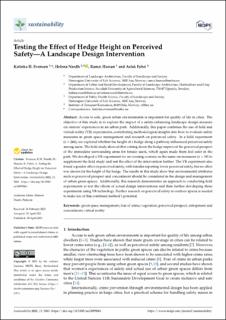| dc.contributor.author | Evensen, Katinka Horgen | |
| dc.contributor.author | Nordh, Helena | |
| dc.contributor.author | Hassan, Ramzi | |
| dc.contributor.author | Fyhri, Aslak | |
| dc.coverage.spatial | Norway, Oslo | en_US |
| dc.date.accessioned | 2023-06-20T07:06:00Z | |
| dc.date.available | 2023-06-20T07:06:00Z | |
| dc.date.created | 2021-05-26T13:45:34Z | |
| dc.date.issued | 2021-04-30 | |
| dc.identifier.citation | Sustainability. 2021, 13 (9), . | en_US |
| dc.identifier.issn | 2071-1050 | |
| dc.identifier.uri | https://hdl.handle.net/11250/3072189 | |
| dc.description | Evensen, K.H.; Nordh, H.; Hassan, R.; Fyhri, A. Testing the Effect of Hedge Height on Perceived Safety—A Landscape Design Intervention. Sustainability 2021, 13, 5063. https://doi.org/10.3390/su13095063 | en_US |
| dc.description.abstract | Access to safe, green urban environments is important for quality of life in cities. The objective of this study is to explore the impact of a safety-enhancing landscape design measure on visitors’ experiences in an urban park. Additionally, this paper combines the use of field and virtual reality (VR) experiments, contributing methodological insights into how to evaluate safety measures in green space management and research on perceived safety. In a field experiment (n = 266), we explored whether the height of a hedge along a pathway influenced perceived safety among users. The field study showed that cutting down the hedge improved the perceived prospect of the immediate surrounding areas for female users, which again made them feel safer in the park. We developed a VR experiment for an evening scenario in the same environment (n = 19) to supplement the field study and test the effect of the intervention further. The VR experiment also found a gender effect on perceived safety, with females reporting lower perceived safety, but no effect was shown for the height of the hedge. The results in this study show that environmental attributes such as perceived prospect and concealment should be considered in the design and management of urban green spaces. Additionally, this research demonstrates an approach to conducting field experiments to test the effects of actual design interventions and then further developing these experiments using VR technology. Further research on perceived safety in outdoor spaces is needed to make use of this combined method’s potential. | en_US |
| dc.language.iso | eng | en_US |
| dc.rights | Navngivelse 4.0 Internasjonal | * |
| dc.rights.uri | http://creativecommons.org/licenses/by/4.0/deed.no | * |
| dc.subject | green space management | en_US |
| dc.subject | fear of crime | en_US |
| dc.subject | vegetation | en_US |
| dc.subject | perceived prospect | en_US |
| dc.subject | entrapment and concealment | en_US |
| dc.subject | virtual reality | en_US |
| dc.title | Testing the effect of hedge height on perceived safety-a landscape design intervention | en_US |
| dc.type | Journal article | en_US |
| dc.type | Peer reviewed | en_US |
| dc.rights.holder | © 2021 by the authors. Licensee MDPI, Basel, Switzerland. This article is an open access article distributed under the terms and conditions of the Creative Commons Attribution (CC BY) license (https:// creativecommons.org/licenses/by/ 4.0/. | en_US |
| cristin.ispublished | true | |
| cristin.fulltext | original | |
| cristin.qualitycode | 1 | |
| dc.identifier.doi | 10.3390/su13095063 | |
| dc.identifier.cristin | 1911990 | |
| dc.source.journal | Sustainability | en_US |
| dc.source.volume | 13 | en_US |
| dc.source.issue | 9 | en_US |
| dc.source.pagenumber | 15 | en_US |
| dc.relation.project | RFFH: 245661 | nb_NO |

